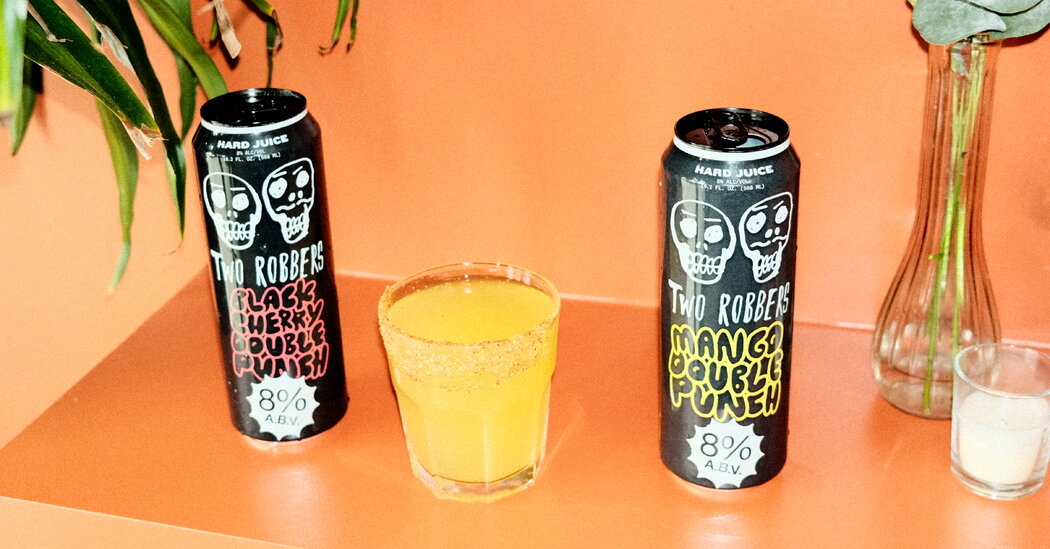
Since its introduction in 1963, SunnyD has been a favorite for generations of American children, served as an after-school treat or at the end of soccer or baseball practice.
But it’s also been a longtime favorite on the house party circuit, which is why Harvest Hill Beverage Company, the brand’s owner since 2016, recently introduced a canned SunnyD Vodka Seltzer. “Our consumers have been using SunnyD and juices as mixers for years,” said Ilene Bergenfeld, Harvest Hill’s chief marketing officer. “We just made it more convenient.”
Harvest Hill is one of a number of breweries and beverage companies breaking into the still-emerging hard juice market. Last year, Molson Coors Beverage Company partnered with the Coca-Cola Company to create Simply Spiked, which contains Simply Beverages’ peach and lemonade juices.
The same month that SunnyD Vodka Seltzer hit the market, New Belgium Brewing released its Wild Nectar line, featuring tropical juice mixes, including strawberry guava and passion fruit lime. Next year, Absolut Vodka and Ocean Spray will join the fray with a canned vodka cranberry cocktail.
For manufacturers, hard juice is part of a natural progression toward alcoholic beverages built around big flavors rather than an alcohol category like beer or wine. “It’s a blurry space, and that’s the point,” Shaun Belongie, the chief marketing officer for New Belgium, said in an email. “Drinkers just want something delicious and refreshing.”
These hard juices are supposed to be displayed with other alcoholic beverages in stores, but some people are concerned that they could be courting underage drinkers.
Even as hard seltzers rack up nearly $4.2 billion in sales, according to NielsenIQ, leaning on household brands and bold fruit combinations might offer companies a novel recipe for additional customers, said Dave Williams, the vice president of analytics and consumer insights for Bump Williams Consulting, which focuses on the alcoholic beverage industry.
“These new beverages have done a good job of resonating with new legal drinking age consumers,” he said.
That’s certainly been the case for Two Robbers Seltzer Company in Philadelphia, which released its first hard seltzers in 2019. This spring, after noticing that consumers were mixing juices into their hard seltzers, the company introduced a hard juice that is 8 percent alcohol by volume and contains 160 to 175 calories per 12-ounce serving.
At the company’s bar in the Fishtown neighborhood of Philadelphia, Two Robbers’ mango Double Punch hard juice might be served with a Tajín rim. “You’re getting a big glass of a beautiful juicy drink,” said Vivek Nayar, a founder.
For its hard juice line, New Belgium produced more than 40 prototypes before settling on about 15 percent juice in hopes of creating a drink “reminiscent of a tropical cocktail you might enjoy on a beach,” Mr. Belongie said.
That percentage might seem a bit low to someone like Juan Cordón Toledano, the Spanish-born owner of SunDaze, which aims to reinvent the mimosa with its line of lightly carbonated, fermented-juice cocktails. With at least 70 percent juice, Mr. Toledano said, “we have the highest juice content in a ready-to-drink cocktail.”
And for beer brewers who have made inroads with fruity and hazy I.P.A.s, hard juices present an opportunity to reach an entirely different audience. In 2020, Homes Brewery in Ann Arbor, Mich., established Troobado and, with it, the fruit-saturated Smooj line of so-called hard smoothies.
At more than 200 calories per 12-ounce serving, it makes for a rich treat, said Tommy Kennedy, the owner of both companies. But then again, “real fruit will have calories.” Smooj has since found a younger following, with customers embracing it for the same reason they started adding juice to their cocktails in the first place.
“You just don’t taste the alcohol,” Mr. Kennedy said.
Follow New York Times Cooking on Instagram, Facebook, YouTube, TikTok and Pinterest. Get regular updates from New York Times Cooking, with recipe suggestions, cooking tips and shopping advice.



